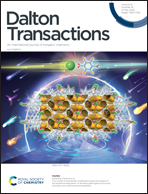Anticancer and biological properties of new axially disubstituted silicon phthalocyanines†
Abstract
This study reports the synthesis of three novel axially disubstituted silicon phthalocyanines (1–3-Si) and their quaternized phthalocyanines (1–3-QSi). The resulting compounds were characterized by applying spectroscopic techniques including 1H NMR, FT-IR, UV–vis, and mass spectroscopy. The biological properties of compounds 1–3-QSi, including DNA cleavage activities, DNA binding modes, and topoisomerase enzyme inhibition activities, were investigated using agarose gel electrophoresis. pBR322 plasmid DNA, CT-DNA, and AL-DNA (isolated from apricot leaf) were used for DNA studies. All the quaternized compounds exhibited acceptable DNA cleavage activities. Human topoisomerase I and E. coli topoisomerase enzymes were used for the topoisomerase I inhibition studies. All the quaternized complexes inhibited topoisomerase I activity. Moreover, these compounds were screened for cytotoxic and apoptotic effects against a human colon cancer cell line (DLD-1) by performing MTT and Annexin V assays. They exhibited toxicity and apoptotic effect on the DLD-1 cell line. The findings reveal that the compounds can be utilized for cancer therapy after further investigations.



 Please wait while we load your content...
Please wait while we load your content...